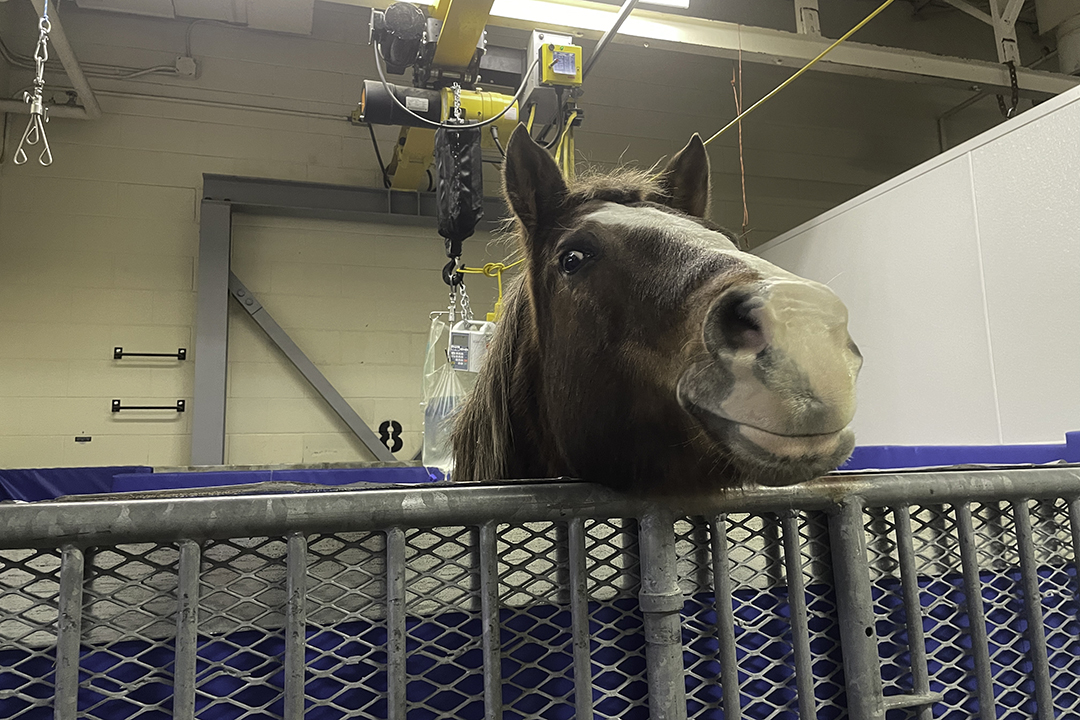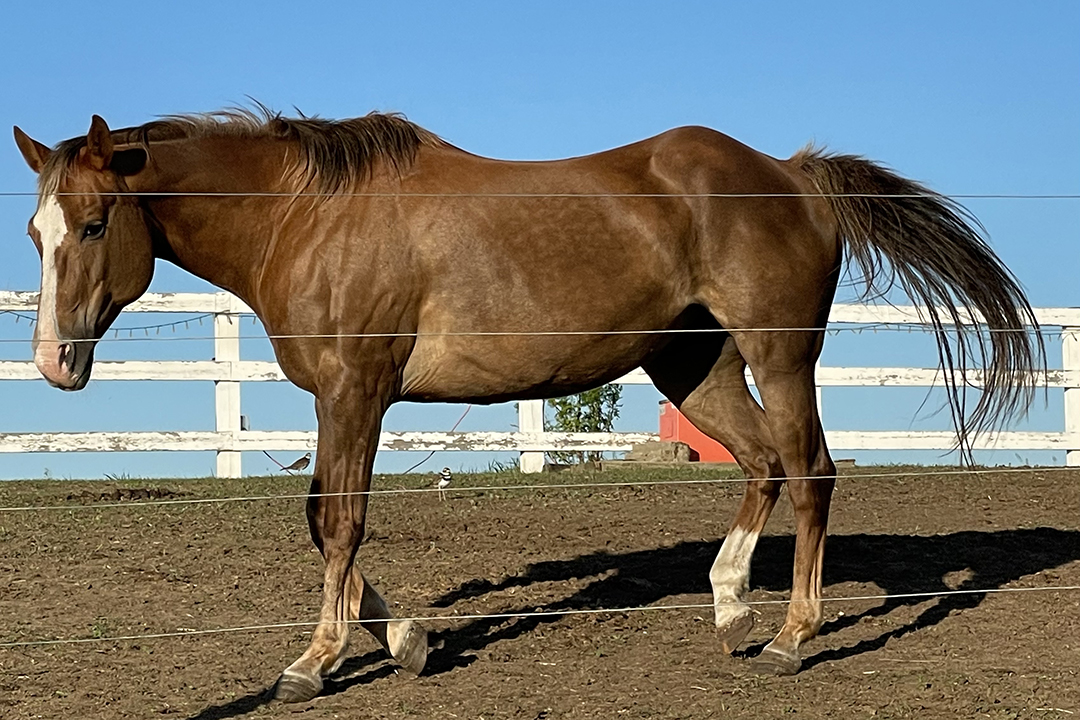
Life after laminitis
If you call Bob Wood, you’ll likely hear birds singing in the background. Before his mare Jessie got sick, Wood could usually be found out in his pasture with his two horses, two dogs and one cat by his side.
By Jeanette Neufeld“We were the joke of the area … ’cause all of us would be walking and hanging together in the pasture,” says Wood, who lives with his animals near Delisle, Sask.
Now, while Wood and the rest of his crew roam nearby, Jessie spends her time in the paddock that her owner built during the horse’s long and difficult recovery from laminitis.
Late last year, Dr. Valentina Ragno, a specialist in large animal internal medicine and clinical associate with the Western College of Veterinary Medicine’s (WCVM) equine field service, was called out to see Jessie, who had become stuck between a row of round bales and a fence and refused to move.
When Ragno arrived, she realized Jessie was in severe pain. The 14-year-old mare was trying to take weight off her front feet because she was suffering from laminitis.
Laminitis is inflammation of the soft tissues called laminae, which attach the horse’s coffin bone (the wedge-shaped bone within the foot) to the hoof wall. In severe cases of the disease, the horse’s coffin bone can shift or rotate away from the hoof wall — a painful, irreversible process that causes severe lameness and often leads to euthanasia.
Jessie was quite overweight, and the clinicians suspected underlying metabolic conditions. However, the first step was to deal with the acute pain she was experiencing.
After Ragno administered systemic pain medications and a nerve block in all four limbs to control Jessie’s pain, the horse was coaxed into a trailer for the short drive to the WCVM’s Veterinary Medical Centre (VMC) where she was kept in a padded stall with a soft floor. Next, WCVM large animal internal medicine specialist Dr. Julia Montgomery and her residents swiftly implemented an intensive therapeutic plan to control Jessie’s pain and to correct her metabolism.
Wood, who was at work in northern British Columbia, finished his shift and started the 14-hour drive back to Saskatoon to be with his ailing horse.
After spending nine days in the hospital, Jessie went home on Christmas Eve, and Wood began the exhaustive process of managing her care. For someone taking time off work, Wood’s to-do list was suddenly very long.
“You couldn’t hire someone to do it,” says Wood, whose days began at 4 a.m. “It’s a good thing I’m already divorced, because I sure would have been.”

While his coffee percolated, Wood gathered up the hay he’d soaked the night before, then began preparing Jessie’s medication. This included two different drugs for pain control and another two medications to regulate her metabolism and boost weight loss.
“A lot of the drugs are formulated for large and small animals, or humans. They come in a low concentration, so we need 30 pills of this, 70 pills of that. It can be a bit overwhelming,” explains Dr. Paula Viviani, a large animal internal medicine resident at the WCVM. She treated Jessie while she was in the hospital and helped with the horse’s follow-up care.
Wood counted and crushed up more than 100 pills twice a day — filling a horse-sized syringe of medication. Jessie didn’t like it much, so Wood began mixing in soaked beet pulp to sweeten the deal.
Added to that was the chore of soaking enough hay to feed a large animal three times daily. This critical step reduces the amount of sugar in the hay, helping to aid weight loss and improve the painful symptoms of laminitis.
Wood also had to regularly take off Jessie’s protective comfort boots, and then clean and check her feet for any sores. Several weeks later, after the clinical team declared the mare sound enough, Wood started to walk his horse on a lead rope in a small outdoor pen.
Throughout the process, he kept in close touch with the WCVM’s equine field service team.
“No matter how many times I asked the same question, they went through the details with me,” he says.
Wood also relied on the support of Joule Tallman, a Saskatoon-area barefoot trimmer who collaborated with the WCVM’s clinical team — including surgery and medical imaging specialists — to determine how to care for Jessie’s afflicted hoofs after assessing how much rotation of the coffin bone had occurred in her front feet.
By using X-ray images taken periodically by the field service team to see what was going on underneath the hoof wall, Tallman trimmed Jessie’s hoofs to align the coffin bone at the proper angle to the ground.
Hoof care is essential for managing laminitis since the length of the toe and angle of the hoof can contribute to the amount of pressure on the foot. Aggravating the foot’s soft tissues and tendons contributes to the pain that the horse experiences and prevents the laminae from growing back properly.
Wood thoroughly followed the advice of Jessie’s care team by agreeing to the recommended diagnostic tests and follow-up exams and giving the prescribed medications as well as feeding her a specific diet, arranging regular hoof trimming and providing her with exercise.
Improvements were initially slow, and the veterinary team didn’t see much change, says Viviani. But after a few months, it was clear that Jessie’s recovery was progressing.
“Sometimes all you have to do is be patient and let the medications and the diet change kick in,” she says.
Managing laminitis for the long term requires dedication from an owner, and the work doesn’t end. Wood religiously followed the advice of Jessie’s care team.
“I figured if I'd taken the time off, she's got 100 per cent of my attention,” he says.
During Jessie’s most recent check-up from the equine field service, her clinicians found a horse in ideal body condition, running happily in her outdoor paddock. Additionally, her follow-up metabolic tests showed that she was able to respond much better to the sugars in her diet compared to her condition in December 2021.
“Everyone who was coming over to see her said she was looking great, but until you hear it from the doc — that kind of hit home,” says Wood.
While Jessie is doing well now, she requires close attention for the rest of her life. She still can’t graze freely — especially during the day when the grass has the highest amount of sugar content. She was diagnosed with equine metabolic syndrome and suspected pituitary pars intermedia dysfunction (previously known as equine Cushing’s disease) and continues to receive medication for the latter conditions. But she no longer requires pain control for laminitis.
While Wood is reluctant to take credit, his care team commends his exceptional efforts.
“Follow up and owner compliance are the key factors. We can help all we can while the horse is in the hospital or when we go on a visit, but at the end of the day, it’s on the owner. It’s a lot of commitment and it's a lot of work,” says Viviani.
Wood was grateful to his employer, who let him take an unprecedented six-month leave from work. He headed back to B.C. this summer and sent Jessie and Beans (his other horse) to board with another WCVM client, who is experienced in managing horses with metabolic conditions.
Wood hopes his next return home will be to a healthy menagerie of animals. But if he had to, he would do it all again.
“She’s my girl,” says Wood. “If it was one of the dogs, if it was the cat, it'd be the same. How can you kick one to the curb? You know, you can't — you can't."
